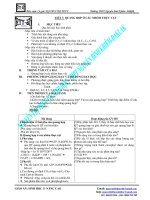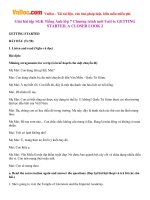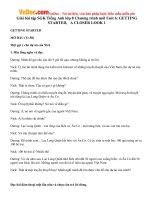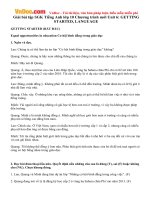Giáo án unit 6 getting started lớp 11
Bạn đang xem bản rút gọn của tài liệu. Xem và tải ngay bản đầy đủ của tài liệu tại đây (132.74 KB, 9 trang )
Unit 6: GLOBAL WARMING
GETTING STARTED – A presentation on global warming
STAGE 1: DESIRED OBJECTIVES/ OUTCOMES
A. OBJECTIVES
By the end of the lesson, students will be able to:
- learn about global warming, the causes of global warming and its effect
- know more about the ways to reduce global warming
1. Language competences
Cognition: asking and answering the questions
Skills: talk about activities to reduce global warming
2. General Competences
Self-control & independent learning: perform individual tasks
Communication and collaboration: work in pairs or groups to perform tasks
3. Attributes
Kindness: help partners complete learning tasks
Diligence: complete tasks
Responsibility: develop a sense of responsibility for reducing global warming
B. LANGUAGE FOCUS
Vocabulary: infectious diseases,heat-related illness, greenhouse gas,carbon footprint
Grammar and Structure/Sentence pattern: the perfect participle
C. INSTRUCTIONAL RESOURCES
1. Teacher
General education program 2018 – Foreign Languages
Reference teaching materials: Textbooks, teacher’s books, and activity books,...
Teaching aids: TV, board, pictures, audio files ...
Assessment tools: Observation sheets, handout …
2. Students
Textbooks, pencils, handout
STAGE 2: ASSESSMENT EVIDENCE
Performance tasks
Performance products
Assessment tools
Answer the question based
Ss’ answers
Observation
on the picture, doing
exercise 2,3
Activity 2, task 3
Ss’ discussion
Observation, questions, and
answers
STAGE 3: LEARNING PLAN/ LEARNING EXPERIENCES
Time
4’
Stages/
Activitie
s
Lead in/
Warmup
ICQ:
1. Do we
watch video
once or
twice?
2. You will take
notes and write
these activities
or you just
listen and watch
Procedu
re
*Aims:
- Creating an active atmosphere in the class before
the lesson
- Leading into the new unit
*Content: to have some warm-up activities to
create a friendly and relaxed atmosphere to inspire
Ss to warm up to the subject and new lesson
*Products: Ss’ answer
*Steps:
- Greeting
- T divides the class into two groups: group A and
group B
- T gives each group a piece of paper
- T gives instructions: Watch the clip one time and
take note of the phrases or the words that the man
has done
CLIP WATCHING
Video link: />v=WfGMYdalClU
- T lets Ss stick the answer on the board
- T shows the answer and checks whether Ss
had any mistakes
- T confirms the winner
- T asks the question: “What is the
consequence of his activities?”
Interaction
s
T Ss
Ss Ss
Activity 1:
Teaching
vocabular
y
8’
- T leads to the new lesson: So “How do we reduce
global warming?” let’s go to our lesson today Unit
6: Global Warming
*Aims: explaining new lexical items relating to the
lesson
*Content: students learn some vocabulary to
use key language more appropriately before
they read and listen
*Products: Ss’ awareness of pronouncing the
words and their meaning
- Teaching vocabulary:
1.Carbon footprint (n) /ˌkɑːbən ˈfʊtprɪnt/: a
measure of the amount of carbon dioxide that is
produced by the activities of a person or company
Ex: The average carbon footprint for a person in
the United States is 16 tons.
2.Infectious diseases (n) /ɪnˈfekʃəs dɪˈziːz/: are
illnesses caused by harmful organisms that get into
your body from the outside.
Ex: COVID-19 is an infectious disease.
3. Heat-related illness (n) /hiːt rɪˈleɪtɪd ˈɪlnəs/:
is one caused by high temperatures and
humidity.
Ex: A heat-related illness occurs when our
bodies can no longer transfer enough heat to
keep us cool.
4. Greenhouse gas (n) /ˌɡriːnhaʊs ˈɡæs/: any of the
gases that are thought to cause the greenhouse effect,
especially carbon dioxide
T Ss
Ss Ss
Ex: The main greenhouse gases whose
concentrations are rising are carbon dioxide, methane,
water vapour.
*Steps:
- T shows the pictures
- T asks Ss some questions
- T introduces new words
- T says the words aloud
- T asks Ss to repeat them
- T checks Ss’ understanding through some questions
- T gives feedback
Activity 2:
Matching
10’
Activity 3: Task
1: Listen and
read
ICQ:
1. How
many
*Aim: Help Ss identify their choice.
*Content: Match the words and phrases with their
definitions.
*Products: Ss’s answer.
*Steps:
+ T asks Ss to work in pairs, do exercise.
+ T encourages Ss to explain their choice.
+ T asks Ss to work by themselves, do the task then
share their answer with their partner.
+ T helps Ss if necessary.
+ T calls some Ss go to the board and write the
answer
+ T checks answers.
* Expected answers:
1. c 2.g 3.d 4.b 5.a 6.e 7.h 8.f
*Aims:
- Getting students interested in the topic
- Getting students to use some vocabulary to be
learned in the unit
- Practicing reading for gist
- Practicing listening skill
- Following lessons
*Content:
- Listening and reading the dialogue
T Ss
Ss Ss
T Ss
Ss Ss
times do
we have to
listen?
*Steps:
- T asks Ss to look at the picture (p.6)
- T asks Ss to answer the following questions:
1. Where are they?
2. What’s their relationship?
3. What are they doing?
*Expected answers:
- They’re in class
- They’re friends
- They’re preparing for their presentation.
- T asks Ss listen once to check the pronunciation of
those words and underline the causes and the effects
of global warming.
- T plays the audio once.
Ms Hoa: Now, Group 2, how are your preparations
going? Is your topic global warming?
Lan: Yes, itis. We've already decided on the main
points to talk about and agreed on the presentation
outline. Having planned the content, we're now
looking for supporting information.
Ms Hoa: Sounds good.
Minh: First, we'll talk about causes such as
greenhouse gas emissions from factories and
vehicles.
Mai: There are also other causes, like the use of
chemical fertilisers and deforestation. Global
warming is man-made!
Minh: Man-made?
Ms Hoa: That's right. in the past, a lot of industries
denied having contributed to global warming, but
nowadays most people admit we are all responsible.
Minh: I see. Then we'll focus on the effects of global
warming on people's health and life on Earth in
general.
Mai: Yes. Having treated the environment
irresponsibly, humans now have to suffer the effects
of global warming. Do you agree, Lan?
Lan: Yes. Global warming leads to climate change,
allowing for some infectious diseases to spread more
easily. We should also make it clear how global
warming contributes to heat-related illnesses and
death.
Mai: It also has severe impact on water supplies,
threatens food production and upsets ecological
balance.
10’
Ms Hoa: These are all excellent points. Have you
come up with any solutions?
Lan: Yes. Ms Hoa. We'll point out how people can
change their daily habits to reduce their carbon
footprint.
Ms Hoa: That's great. Now, go through all your
points again and decide who in your group will
present each part.
Lan, Minh, and Mai: Thanks for your help, Ms
Hoa.
*Expected answers:
The causes: greenhouse gas emissions
from
factories and vehicles ,use of chemical fertilisers
and deforestation
The effects: leads to climate change,infectious
diseases,heat-related illnesses and death,impact on
water supplies,threatens food production,upsets
ecological balance
Activity 4: Task
2: Read the
conversation
again and
answer the
following
questions
7’
6’
*Aim: helping Ss interpret the reading text
through the task.
*Content: completing Exercise 2 in the textbook
*Products: Ss’ awareness of main details
related to the conversation
* Steps:
- T asks Ss to work individually to read the
ICQ:
questions and underline the keywords
- T corrects their answers as a class
1. How many
questions are Suggested answers:
there?
1. What is the topic of Lan, Mai and Minh's
2. How many presentation?
2. How many main parts do they intend to include in
mystery
numbers are their presentation ? What are they?
3. What causes of global warming are mentioned in
there?
the conversation ?
4. What effects of global warming do they talk
about?
5. According to Lan, what do people need to change
to reduce their carbon footprint?
6. Can you add some more causes and effects of
global warming besides those mentioned in the
conversation?
- T asks Ss to scan the conversation and locate the
keywords to find the answer for each question
- T asks Ss to play a mini-game (mystery number)
- T divides the class into two groups and has Ss in
each
group take turns choosing a number in the game
Mystery Number to check the answers
-Ss listen to T’s instruction
-Ss play the mini-game
Suggested answers:
1. Global warming
T Ss
Ss Ss
Activity 5: Task
3: Find the
sentences with
the structure
having + past
participle in the
conversation and
write them down
in the space
below
2. Three parts: the causes, the effects, the solutions
3. Greenhouse gas emissions from factories and
vehicles; use of chemical fertilizers, and
deforestation.
3. Greenhouse gas emission, use of chemical
fertilizers, deforestation
4. Climate changes, infectious and heat-related
diseases, impact on water supplies, threat to food
production and upset ecological balance
5. They should change their daily habits
6. Causes: burning of fossil fuels, using of nonenvironment friendly products
Effects: natural disasters such as floods, droughts,
tsunami, acid rain
*Aim: helping Ss interpret the reading text
through th e task.
*Content: completing Exercise 4 in the textbook
*Products: Ss’ answers
* Steps:
- T asks Ss to find the sentences with the structure “
having+past participle”
- T shows the model first
*suggested answer
-In the past, a lot of industries denied having
contributed to global warming.
-Having treated the environment irresponsibly,
humans now have to suffer the effects of global
warming
Production/
further practice
*Aim: Helping students practice talking about
activities which help reduce the global
warming
*Content: asking and answering
*Products: Ss’ understanding
* Steps:
- T shows the question “How to
T Ss
Ss Ss
T Ss
Ss Ss
Homework
reduce the global warming?”
- T asks Ss to answer the question using “We
should…”
*Aim: Consolidating what Ss have learnt
*Content: Exercises in the workbook
*Products: Ss’ answer
*Steps:
- T reminds Ss to finish the exercises in the
workbook.









